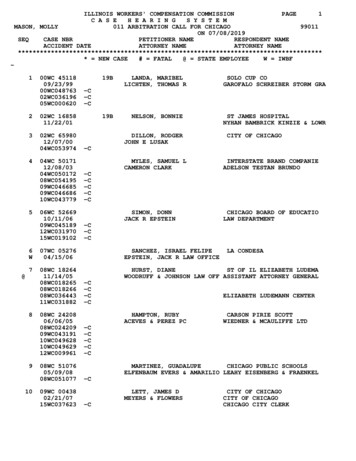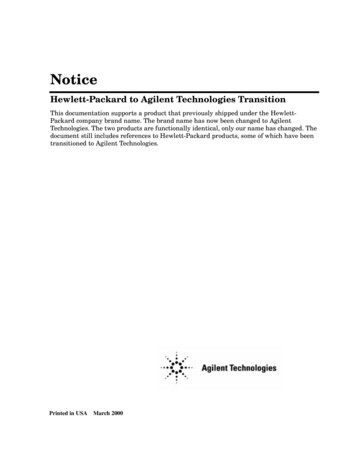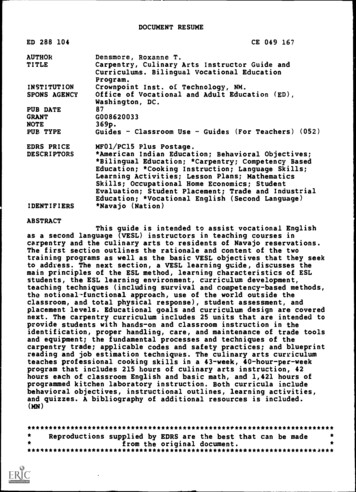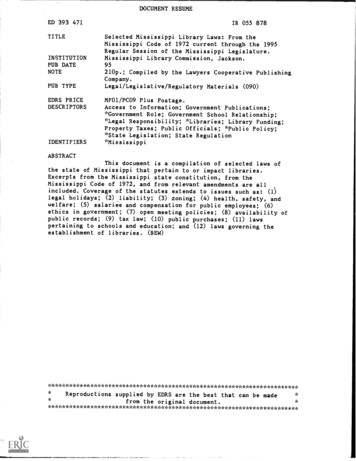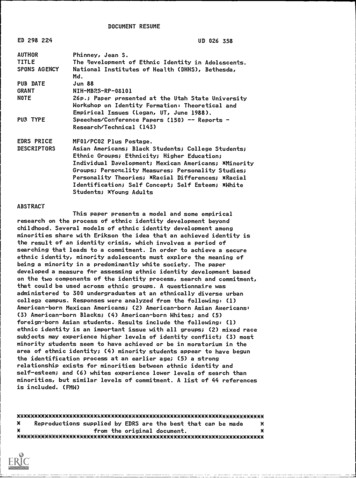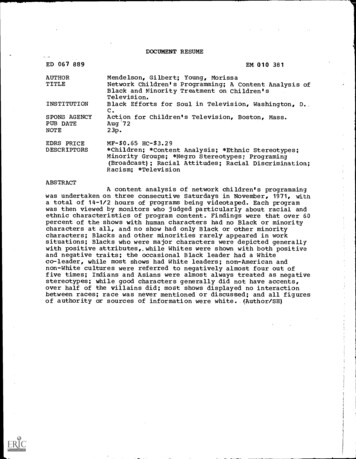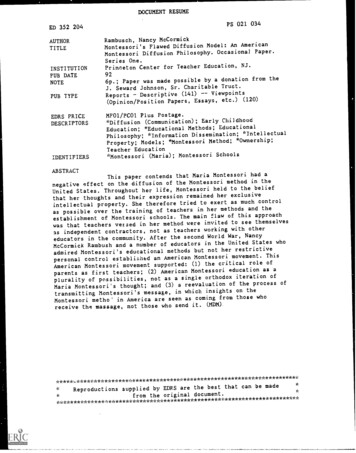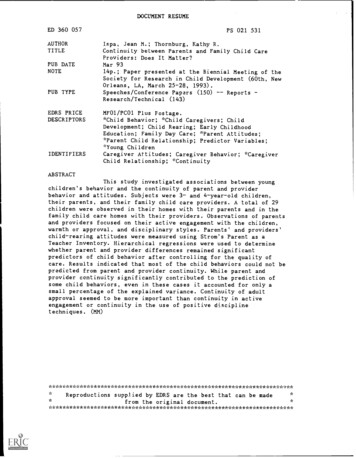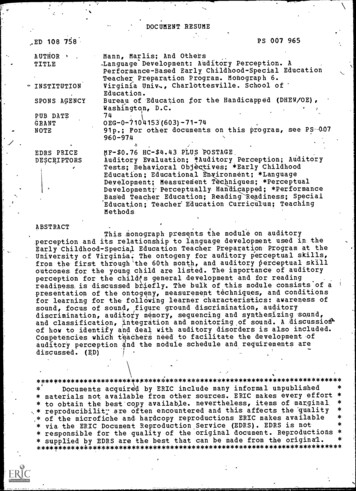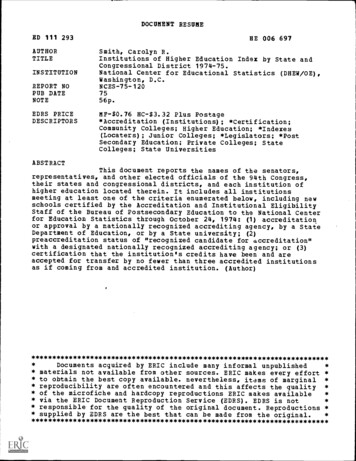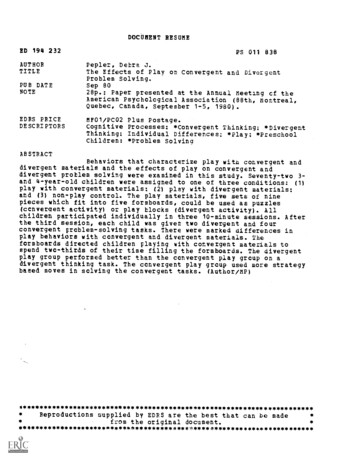
Transcription
DOCUMENT RESUMEED 194 232AUTHORTITLEPUB DATENOTEEDRS PRICEDESCRIPTORSPS 011 B3BPepler, Debra J.The Effects of Play on Convergent and DivergentProblem Solving.Sep BO28p.: Paper presented at the Annual Meeting et theAmerican Psychological Association (88th, Montreal,Quebec, Canada, September 1-5, 1980).MF01/PCO2CognitiveThinking:Children:Plus Postage.Processes; *Convergent Thinking; *DivergentIndividual Differences; *Play; *Preschool*Problem SolvingABSTRACTBehaviors that characterize play with convergent anddivergent materials and the effects of play on convergent anddivergent problem solving were examined in this study. Seventy-two Sand 4-year-old children were assigned to one of three conditions: (1)play with convergent materials: (2) play with divergent materials:and (3) non-play control. The play materials, five sets of ninepieces which fit into five formboards, could be used as puzzles(ccnvergent activity) or play blocks (divergent activity). Allchildren participated individually in three 10-minute sessions. Afterthe third session, each child was giver two divergent and fourconvergent problem-solving tasks. There were marked differences inplay behaviors with convergent and divergent materials. Theformboards directed children playing with convergent materials tospend twc-thirds of their time filling the formboards. The divergentplay group performed better than the convergent play group on adivergent thinking task. The convergent play group used more strategybased moves in solving the convergent tasks. ********************************Reproductions supplied by EDRS are the best that can be madefrom the original ******************************
U.S. DEPARTMENT OF HEALTH,EDUCATION & WELFARENATIONAL INSTITUTE OFEDUCATIONTHIS DOCUMENT HAS BEEN REPRDUCED EXACTLY AS RECEIVED FROMTHE PERSON OR ORGANIZATION ORIGINATING IT POINTS OF VIEW OR OPINIONSSTATED DO NOT NECESSARILY REPRE.SENT OFFICIAL NATIONAL INSTITUTE OFEDUCATION POSITION OR POLICYThe Effects of Play on Convergent and Divergent Problem SolvingDebra J. PeplerCentre for Research in Human DevelopmentErindale College, University of TorontoPresented at the American Psychological Association meeting, Montreal,September, 1980."PERMISSION TO REPRODUCE THISMATERIAL HAS BEEN GRANTED BYlerTO THE EDUCATIONAL RESOURCESINFORMATION -ENTER (ERIC)."
AbstractThis research examined the behaviors that characterize play with convergent and divergent materials and the effects of play on convergent anddivergent problem solving.There were 72 three and four year old childrenassigned to one of three conditions:(1) play with convergent materials;(2) play with divergent materials; and (3) non-play control.The playmaterials, five sets of nine pieces which fit into five formboards, couldbe used as puzzles (convergent activity) or play blocks (divergent activity).All children participated individually in three ten-minute sessions.Afterthe third session, each child was given two divergent and four convergentproblem-solving tasks.There were marked differences in play behaviors withconvergent and divergent materials.The formboards directed children play-ing with convergent materials to spend two-thirds of their time filling theformboards.The divergent play group performed better than the convergentplay group on a divergent thinking task.mt.The convergent play group usedstrategy based moves in solving the convergent tasks.3
This research examined the effects of play on problem-solving.Twotypes of play experience were provided; children were allowed to play witheither convergent materials (those that tend to direct play to a singlesolution, in this case, puzzle solving) or divergent materials (those thatfacilitate a variety of play activities).Following the play experience,the children were presented with both convergent and divergent problemsolving tasks.Observations of the play and problem-solving sessions pro-vided information about the processes underlying play and problem-solvingand the relations of these different play experiences to two types ofproblem-solving.There is a widespread belief among developmental psychologists andeducators that play is a medium through which children develop cognitiveskills.Although numerous studies claim a developmental function for play,there is little research to confirm the relation between play and problemsolving.In general, theorists have postulated several elements of playexperience that might contribute to the development of problem-solvingskills.First, investigation or exploration of objects is presumed to .ro-vide information about them (Hutt, 1976; McCall, 1974).Attending to andexperimenting with the properties of objects during play might direct thechild to a strategy of attending to such properties in problem solving.Second, experimentation in play may contribute to flexibility in the child'sresponses (Bruner, 1976).Through object exploration and play, the childmay develop a broad repertoire of skills and a tendency to experiment thatcould transfer to the mastery of problems requiring a novel solution or avariety of solutions.Third, play may allow the child to exercise existingskills and intelligence (Bruner, 1976; Smilansky, 1968).Finally, thefantasy element of play may facilitate the transition from concrete to4
abstract thought leading the child to early symbolic thinking (Fein, 1979;Piaget, 1962; Vygotsky, 1976).An example is the child's developing theability to pretend that a block if: a house; this newly formed capacity toabstract can be practised and vat'ad in play.Such representational thoughtmay facilitate solving a problem that requires the formation of a mentalmodel or symbolic thought (e.g., What could this block be?).Solving convergent problemsA convergent problem has one and only one solution.studies have examined the efficacyAlthough severalof play for solving convergent problems,the results are equivocal or of limited generality since they are restrictedto one task -- joining sticks together to obtain a lure.Generally, thisresearch has shown that children given play experience with the sticks performed better on the task than children who had no experience.Sylva, Bruner & Genova (1976) compared the effect of play experience toobservation of a principle required for the task and to a no treatment condition.Although the play group was clearly superior to the no treatmentcondition in their task performance, the superiority of the play group ascompared to the observe principle group is tenuous.The authors reportedthat children in the play group required fewer hints, had more goal-directedresponses, and were categorized as "learners" more frequently (i.e., movingfrom simple to complex means) as compared to children in the observe principle condition.They failed to note that almost half of the successfulchildren in the observe principle group solved the problem on their firstattempt and, therefore, did not require any hints, did not need more thanone goal-directed response, and were not categorized as "learners" althoughthey had clearly learned the solution.Two other studies have extended the research of Sylva et al.Vandenberg
- 3(1978) examined a larger age range and tasks of varied difficulty and founda similar difference in task performance in favor of the group with playexperience, as compared to instructional experience.The replication, how-ever, held only for a task very similar to the one used by Sylva, and notfor a simpler task.Smith and Dutton (1979) extended the play versus train-ing paradigm to direct and innovative problem- solving.When the trainingsession related directly to the task of joining two sticks together, theplay and training groups were equivalent in their problem-so.4-7ing perfor-mances and both were superior to a control group.On a more complex taskof joining three sticks together, which had not been directly taught to thetraining group, the play group performed better than both the training andcontrol groups indicating that play experience may be beneficial for a taskwhich requires innovative transfer.Solving divergent problemsPlay has been shown to facilitate solving a divergent problem -- onewhich has no single correct solution, but a variety of possible solutions.Dansky and Silverman (1973) investigated the effects of play with objectson solving a divergent problem in which the children were asked the alternate uses for those objects.Children who had play experience were superiorto an imitation and a control group on the number of non-standard responsesto the objects.In a subsequent study, this result was replicated usingdifferent objects in the play and task conditions indicating that the benefits of play experience generalize to solving problems with unfamiliar objects (Dansky and Silverman, 1975).A recent study by Dansky (1980) examined the role of make-believe playin enhancing divergent thinking studies.Preschool children were observedduring free-play, categorized as either players (who displayed make-believe)6
-4or non-players, then assigned to one of three treatment conditionsplay, imitation, and problem-solving).(freeChildren who were "players" and hadfree-play experience were superior to all the other children on an alternate-uses test.This study showed that providing children with free playexperience will not necesarily enhance divergent thinking, but that it ismake-believe activity in play which is crucial in facilitati-g divergentthinking.Play activities that contribute to problem solvingThe research to date has raised several questions about the relationbetween play and problem - solving.First, a review of the related theoriessuggests that different elements of play may relate to different learningexperiences.If these elements cy play are present in varying degrees indifferent forms of play, one might expect related differences in subsequentproblem- solving.The studies reviewed above have examined the effects ofplay on problem-solving, but have failed to document the different elementsin the play experiences that might contribute to differential problem-solving.The current research has examined the play behaviors associated with convergent and divergent materials and related these to subsequent problem-solvingperformance.Second, the only convergent problem examined in previous re-search has been that: of joining sticks together to obtain a lure and theonly divergent problem has been an alternate uses task.The current re-search has extended the range of both convergent and divergent problemspresented following play experience.Finally, all play experiences provi-ded in the previous studies have been divergent in nature, that is, notdirected themselves to the solution of a set problem.The current researchadds to the earlier data base by considering the effects of both convergentplay on both convergent and divergent problem-solving thereby providing an
-5 extension and integration of the casual evidence from previous play research.The author has conducted two studies of play and problem solving, butwill only be detailing the results of the second study in this paper.Insummary, the first study (Pepler, 1979) revealed marked differences in playwith convergent as compared to divergent materials.The children who playedwith the divergent materials were also shown to perform better on a divergent thinking task than either the convergent play group or control groups.There were no differences among the groups on convergent problem - solvingmeasures.The second study served as a replication of:(1) the differences inplay behavior with convergent and divergent materials and (2) the effectof play on divergent problem solving.It extended the findings of the firststudy by including another divergent thinking task and convergent taskswhich were more similar to the convergent play materials.MethodThe children.The sample comprised 72 children from three daycarecentres in southern Ontario.The children were equally divided by sex andage, 3 years old (M 3.6) and 4 years old (M 4.6).They were Englishspeaking and generally middle class.Materials.There were five sets of play materials.A set consistedof nine different-colored pieces which fit into a white formboard.Thefive sets of materials were animals, vehicles, regular shapes, randomshapes and squares.They could be used either as a puzzle by fitting theiieces into the formboard, or as play blocks since the pieces were 1.9 rm.thick and were free-standing.resign.The children were randomly assigned to one of three condi-tions balanced for age and sex.The three conditions were:(1) play with
-6 convergent materials, (2) play with divergent materials, and (3) non-playcontrol.All children were seen individually for three ten-minute sessionsconducted on separate days within a five-day period; a battery of problemsolving tasks was administered on the day of the last session.Experimental Setting.The play and non-play control sessions wereconducted in a separate room in each daycare centre, away from the mainactivity area.to the sessions.A camera, videotape recorder and monitor were set up priorChildren in all conditions were videotaped during thethree sessions.Procedure.In the convergent play condition, the children had allfive sets of play materials including both the formboards and the pieces.It was assumed that the formboard suggested a problem with a single solution -- a convergent activity.In the divergent play condition, the chil-dren had the pieces, but not the formboards; therefore, there was no correct solutton for the play activity, but a variety of possible play uses -a diverge?. activity.to play with the toys.not exposedChildren in both play conditions were asked simplyChildren in the non-play control condition were:o the play materials, but spent an equal amount of time read-ing books with the experimenter.Play behaviors.From the videotapes of the
children participated individually in three 10-minute sessions. After the third session, each child was giver two divergent and four convergent problem-solving tasks. There were marked differences in play behaviors with convergent and divergent materials. The formboards directed children playing with convergent materials to
